In the world of e-learning, there are several standards that are used to ensure compatibility and interoperability between different learning management systems (LMS) and e-learning content. These standards are constantly evolving and being updated to keep up with the ever-changing landscape of technology and instructional design. In this article, we will explore the differences between four of the most commonly used e-learning standards: AICC, SCORM, xAPI, and cmi5.
What Are E-Learning Standards?
E-learning standards are a set of guidelines and specifications that define how e-learning content and LMSs should communicate with each other. These standards ensure that e-learning content can be easily shared and used across different platforms and systems. They also provide a framework for instructional designers to create effective and engaging e-learning courses.
Why Are E-Learning Standards Important?
E-learning standards are important for several reasons:
- Compatibility: Standards ensure that e-learning content can be used on different LMSs without any compatibility issues.
- Interoperability: Standards allow different systems to communicate with each other, making it easier to share and track e-learning content.
- Consistency: Standards provide a framework for instructional designers to create consistent and effective e-learning courses.
- Flexibility: Standards allow for the use of different types of media and technologies in e-learning courses, making them more engaging and interactive.
AICC (Aviation Industry Computer-Based Training Committee)
AICC is one of the oldest e-learning standards, developed in the late 1980s by the Aviation Industry Computer-Based Training Committee. It was originally designed for the aviation industry, but it has since been adopted by other industries as well.
How Does AICC Work?
AICC is a set of guidelines that define how e-learning content should communicate with an LMS. It uses a communication protocol called HTTP to send and receive data between the content and the LMS. AICC also specifies how data should be formatted and organized, making it easier for different systems to understand and use the data.
Pros and Cons of AICC
Pros:
- Compatibility: AICC is compatible with most LMSs, making it a good choice for organizations that use different LMSs.
- Flexibility: AICC allows for the use of different types of media and technologies in e-learning courses.
Cons:
- Outdated: AICC is one of the oldest e-learning standards and has not been updated in many years, making it less relevant in today’s e-learning landscape.
- Limited Tracking: AICC has limited tracking capabilities compared to newer standards like SCORM and xAPI.
SCORM (Sharable Content Object Reference Model)
SCORM is a set of technical standards developed by the Advanced Distributed Learning (ADL) Initiative in the late 1990s. It is the most widely used e-learning standard and is supported by most LMSs.
How Does SCORM Work?
SCORM is a set of guidelines that define how e-learning content should communicate with an LMS. It uses a communication protocol called JavaScript to send and receive data between the content and the LMS. SCORM also specifies how data should be formatted and organized, making it easier for different systems to understand and use the data.
Pros and Cons of SCORM
Pros:
- Compatibility: SCORM is supported by most LMSs, making it a good choice for organizations that use different LMSs.
- Interoperability: SCORM allows for the exchange of data between different systems, making it easier to share and track e-learning content.
- Tracking: SCORM has robust tracking capabilities, allowing for detailed reporting on learner progress and performance.
Cons:
- Limited Flexibility: SCORM has limited support for newer technologies and media types, making it less flexible compared to newer standards like xAPI.
- Complex Implementation: Implementing SCORM can be complex and time-consuming, requiring technical expertise and resources.
xAPI (Experience API)
xAPI, also known as Tin Can API, is a newer e-learning standard developed by the ADL Initiative in 2013. It was designed to overcome the limitations of SCORM and provide a more flexible and robust standard for tracking learning experiences.
How Does xAPI Work?
xAPI uses a different approach compared to AICC and SCORM. Instead of using a specific communication protocol, xAPI uses a simple and flexible format called “statements” to send and receive data between the content and the LMS. These statements can be sent over any type of network connection, making it easier to track learning experiences on different devices and platforms.
Pros and Cons of xAPI
Pros:
- Flexibility: xAPI is more flexible compared to AICC and SCORM, allowing for the use of different types of media and technologies in e-learning courses.
- Tracking: xAPI has robust tracking capabilities, allowing for detailed reporting on learner progress and performance.
- Offline Tracking: xAPI allows for offline tracking, making it possible to track learning experiences even when there is no internet connection.
Cons:
- Complex Implementation: Implementing xAPI can be complex and time-consuming, requiring technical expertise and resources.
- Limited Compatibility: xAPI is not yet supported by all LMSs, making it less compatible compared to AICC and SCORM.
cmi5 (Computer Managed Instruction)
cmi5 is a newer e-learning standard developed by the Aviation Industry Computer-Based Training Committee in 2016. It was designed to overcome the limitations of AICC and provide a more modern and flexible standard for tracking learning experiences.
How Does cmi5 Work?
cmi5 is based on xAPI and uses the same “statements” format to send and receive data between the content and the LMS. However, cmi5 also includes additional guidelines and specifications for tracking learning experiences, making it more robust and comprehensive compared to xAPI.
Pros and Cons of cmi5
Pros:
- Compatibility: cmi5 is compatible with most LMSs, making it a good choice for organizations that use different LMSs.
- Flexibility: cmi5 allows for the use of different types of media and technologies in e-learning courses.
- Tracking: cmi5 has robust tracking capabilities, allowing for detailed reporting on learner progress and performance.
Cons:
- Limited Adoption: cmi5 is a newer standard and is not yet widely adopted by LMSs, making it less compatible compared to AICC and SCORM.
- Complex Implementation: Implementing cmi5 can be complex and time-consuming, requiring technical expertise and resources.
Which E-Learning Standard Should You Use?
The choice of which e-learning standard to use depends on several factors, including the type of content you are creating, the LMS you are using, and your organization’s specific needs and goals. Here are some general guidelines to help you make the right choice:
- If you are creating simple e-learning courses with basic tracking requirements, AICC may be a good choice.
- If you are using a traditional LMS and need robust tracking capabilities, SCORM is the most widely supported standard.
- If you are creating more complex and interactive e-learning courses, xAPI may be a better choice.
- If you need a more comprehensive and modern standard for tracking learning experiences, cmi5 is a good option.
Conclusion
E-learning standards play a crucial role in ensuring compatibility, interoperability, and consistency in the world of e-learning. While AICC and SCORM have been the go-to standards for many years, newer standards like xAPI and cmi5 offer more flexibility and robust tracking capabilities. When choosing an e-learning standard, it is important to consider your organization’s specific needs and goals to make the right choice. By understanding the differences between these standards, you can ensure that your e-learning content is compatible and effective across different platforms and systems.







